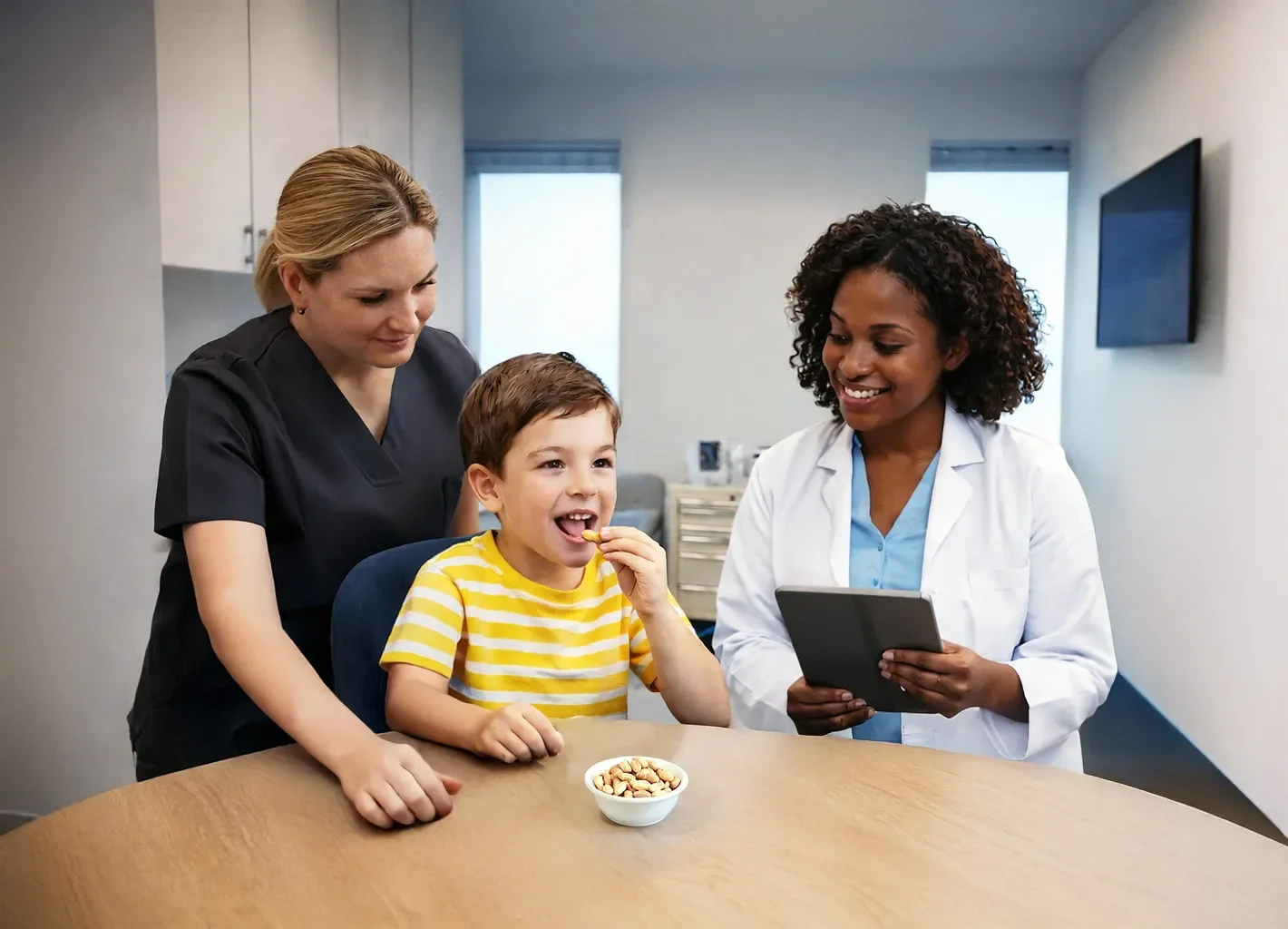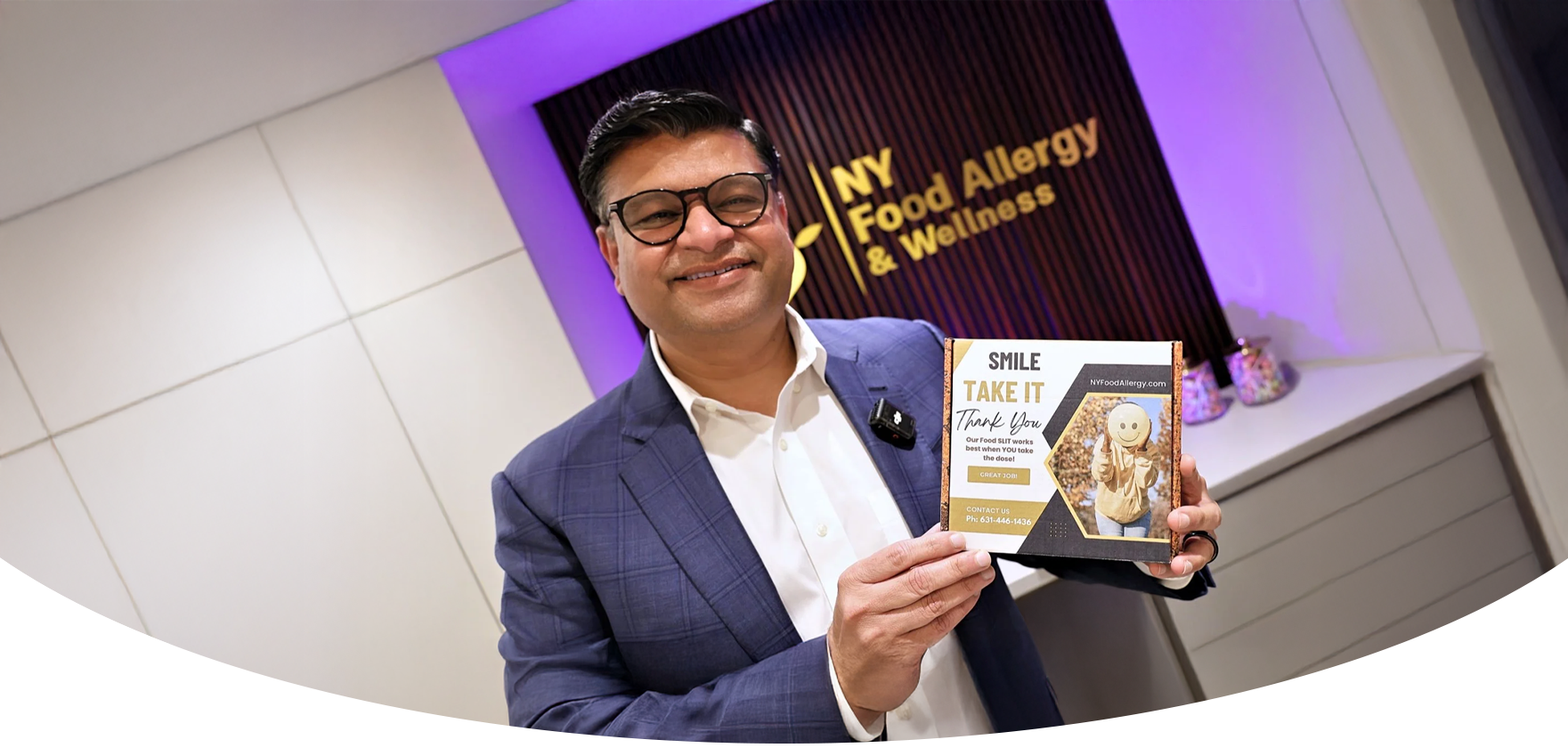Understanding the
Oral Food Challenge
Food allergies can cause reactions ranging from mild symptoms to serious, life-threatening responses. An Oral Food Challenge (OFC) is widely considered the gold standard for confirming a food allergy by carefully observing how your body responds to a measured amount of a specific food in a controlled setting. The results help clarify diagnosis and guide next steps for safer management.
FOOD ALLERGY TESTING:
Oral Food Challenges (OFC)
Under close medical monitoring, patients consume carefully measured amounts of an allergen to confirm a diagnosis or see whether tolerance has developed.
During an Oral Food Challenge, the patient consumes gradually increasing amounts of the suspected allergenic food in a controlled setting. Doses are given in stages, with observation periods in between so that any symptoms can be identified early.
Throughout the process, medical staff closely monitor breathing, skin, blood pressure, and other vital signs. If symptoms appear, the challenge is stopped and treatment is provided right away.
OFCs are used to confirm whether a food allergy is truly present or to check if a patient has outgrown a known allergy. They can also help clarify gray-area situations where IgE tests and clinical history do not fully agree.
The outcome of an OFC directly guides next steps in the FATE Program, whether to maintain avoidance, adjust emergency plans, or begin desensitization with SLIT or OIT.
Because there is a risk of triggering an allergic reaction, OFCs are always performed in a clinical setting with full emergency response capabilities.
At NY Food Allergy & Wellness, challenges are supervised by experienced allergy specialists with immediate access to medications and equipment. Doses are tailored to the individual, and safety is prioritized at every step.
Oral Food Challenge Overview, Safety, and Results
Oral Food Challenge
An Oral Food Challenge (OFC) is a precise, regulated method used to accurately diagnose food allergies. It is performed in a medical setting so dosing can be carefully controlled and your response can be monitored closely.
Sensitization vs True Food Allergy
OFCs help distinguish sensitization from a true food allergy, especially when prior testing results do not fully match symptoms or history. Understanding the potential for severe reactions is part of the planning process so the challenge is approached with the right precautions.
OFC Safety and Outcomes
Our clinical experience has identified predictors that can influence outcomes. Because an OFC can be complex and carries risk, it requires close observation by a trained medical team. When an OFC is successful, it can reduce or eliminate unnecessary avoidance and expand everyday food freedom.
Oral Food Challenge
An Oral Food Challenge (OFC) is a precise, regulated method used to accurately diagnose food allergies. It is performed in a medical setting so dosing can be carefully controlled and your response can be monitored closely.
Sensitization vs True Food Allergy
OFCs help distinguish sensitization from a true food allergy, especially when prior testing results do not fully match symptoms or history. Understanding the potential for severe reactions is part of the planning process so the challenge is approached with the right precautions.
OFC Safety and Outcomes
Our clinical experience has identified predictors that can influence outcomes. Because an OFC can be complex and carries risk, it requires close observation by a trained medical team. When an OFC is successful, it can reduce or eliminate unnecessary avoidance and expand everyday food freedom.
The Oral Food Challenge Process
Why Oral Food Challenges Are Done
Oral Food Challenges (OFCs) are considered the standard for diagnosing food allergies. This precise process provides a comprehensive evaluation of an individual’s allergic response and can be a crucial tool in allergy management. When the diagnosis is in doubt, an OFC can help determine true food allergy versus sensitization.
OFC Safety in a Medical Setting
An OFC should only be performed by experienced allergists with the medications and equipment needed to manage reactions. Symptoms during the procedure are often mild, such as flushing or hives, while severe reactions are less common. This is why the challenge is done under close supervision in a medical setting.
Open OFC Timeline and What to Expect
The open OFC is typically completed in one clinic visit that lasts about 3 to 4 hours. Portions of the suspected allergen are given in steadily increasing amounts over about 2 to 3 hours, followed by an additional 60 to 90 minutes of observation after the last dose. We have the resources to manage allergic reactions if needed, and the OFC remains one of the most reliable approaches available for accurately confirming or ruling out a food allergy.
Why Oral Food Challenges Are Done
Oral Food Challenges (OFCs) are considered the standard for diagnosing food allergies. This precise process provides a comprehensive evaluation of an individual’s allergic response and can be a crucial tool in allergy management. When the diagnosis is in doubt, an OFC can help determine true food allergy versus sensitization.
OFC Safety in a Medical Setting
An OFC should only be performed by experienced allergists with the medications and equipment needed to manage reactions. Symptoms during the procedure are often mild, such as flushing or hives, while severe reactions are less common. This is why the challenge is done under close supervision in a medical setting.
Open OFC Timeline and What to Expect
The open OFC is typically completed in one clinic visit that lasts about 3 to 4 hours. Portions of the suspected allergen are given in steadily increasing amounts over about 2 to 3 hours, followed by an additional 60 to 90 minutes of observation after the last dose. We have the resources to manage allergic reactions if needed, and the OFC remains one of the most reliable approaches available for accurately confirming or ruling out a food allergy.
Ready to Speak With Our Care Team?
GET IN TOUCH
Fill out the form below to begin your journey towards Food Allergy Freedom. Our care team will respond shortly!
The Necessity of Oral Food Challenges in Allergy Diagnosis
When Skin and Blood Tests Are Inconclusive
Allergic reactions can be evaluated through skin and blood tests, but results are not always conclusive. In those situations, an allergist may recommend an oral food challenge (OFC) to more clearly assess whether the suspected food triggers symptoms during supervised ingestion.
Sensitization vs True Food Allergy
An OFC provides a practical, real-world evaluation and can help determine whether sensitization or a true food allergy is present. Because an OFC can provoke significant reactions, including anaphylaxis, it must be thoughtfully selected and performed in a controlled medical setting.
Reducing OFC Risk With BAT Testing
To supplement traditional testing, the Basophil Activation Test (BAT) has shown potential for diagnosing food allergies with notable specificity while helping predict reaction intensity. In some cases, BAT may help reduce the need for an OFC. Learn more about BAT.
When Skin and Blood Tests Are Inconclusive
Allergic reactions can be evaluated through skin and blood tests, but results are not always conclusive. In those situations, an allergist may recommend an oral food challenge (OFC) to more clearly assess whether the suspected food triggers symptoms during supervised ingestion.
Sensitization vs True Food Allergy
An OFC provides a practical, real-world evaluation and can help determine whether sensitization or a true food allergy is present. Because an OFC can provoke significant reactions, including anaphylaxis, it must be thoughtfully selected and performed in a controlled medical setting.
Reducing OFC Risk With BAT Testing
To supplement traditional testing, the Basophil Activation Test (BAT) has shown potential for diagnosing food allergies with notable specificity while helping predict reaction intensity. In some cases, BAT may help reduce the need for an OFC. Learn more about BAT.
Oral Food Challenge Safety and Accurate Food Allergy Diagnosis
Distinguishing Between Sensitization and True Allergies
It is essential to recognize the difference between being sensitized to a food allergen and having a true food allergy, since this can affect how it should be managed. Sensitization may not cause symptoms, while a true allergic response can lead to life-threatening anaphylaxis. Avoiding unnecessary dietary restrictions whenever possible can support quality of life. An oral food challenge (OFC) can help determine whether someone has a true food allergy or is only sensitized, so appropriate care plans can be made.
Understanding the Risk of Severe Reactions
Before an OFC, it is important to understand the possible risks associated with allergic reactions. Many reactions can be recognized early and treated when mild, while anaphylaxis is less common. Some individuals with more severe allergy profiles may show higher basophil reactivity, suggesting a relationship between this activity, symptom intensity, and reaction thresholds.
How BAT Can Support Safer OFCs
The Basophil Activation Test (BAT) may help reduce risk by providing additional insight into basophil activity and potential reaction intensity. When appropriate, BAT can help guide decision-making and support safer OFC planning. To minimize health risks during an OFC, we take all necessary steps and maintain the resources needed to manage reactions if they occur. Learn more about BAT.
Distinguishing Between Sensitization and True Allergies
It is essential to recognize the difference between being sensitized to a food allergen and having a true food allergy, since this can affect how it should be managed. Sensitization may not cause symptoms, while a true allergic response can lead to life-threatening anaphylaxis. Avoiding unnecessary dietary restrictions whenever possible can support quality of life. An oral food challenge (OFC) can help determine whether someone has a true food allergy or is only sensitized, so appropriate care plans can be made.
Understanding the Risk of Severe Reactions
Before an OFC, it is important to understand the possible risks associated with allergic reactions. Many reactions can be recognized early and treated when mild, while anaphylaxis is less common. Some individuals with more severe allergy profiles may show higher basophil reactivity, suggesting a relationship between this activity, symptom intensity, and reaction thresholds.
How BAT Can Support Safer OFCs
The Basophil Activation Test (BAT) may help reduce risk by providing additional insight into basophil activity and potential reaction intensity. When appropriate, BAT can help guide decision-making and support safer OFC planning. To minimize health risks during an OFC, we take all necessary steps and maintain the resources needed to manage reactions if they occur. Learn more about BAT.
Preparing for an Oral Food Challenge
Medication Guidelines Before an OFC
Before an oral food challenge (OFC), certain steps and precautions help protect accuracy and safety. Some medications, such as antihistamines, may need to be avoided in the days leading up to the appointment because they can affect results. Follow the medication instructions provided by your allergist to ensure the most reliable outcome.
Eating and Timing Before Your Visit
Patients are often asked to avoid eating for 1 to 2 hours before arriving for the challenge. These timing guidelines can help reduce variables and support a safer experience. Following the pre-visit instructions closely is an important part of preparing for the procedure.
What to Bring and How We Prepare You
Our team communicates with patients and families in advance about what to bring on the day of the scheduled OFC. We aim to make the experience seamless and comfortable. During the challenge, patients should report any discomfort or symptoms right away so the clinical team can respond quickly and appropriately.
Medication Guidelines Before an OFC
Before an oral food challenge (OFC), certain steps and precautions help protect accuracy and safety. Some medications, such as antihistamines, may need to be avoided in the days leading up to the appointment because they can affect results. Follow the medication instructions provided by your allergist to ensure the most reliable outcome.
Eating and Timing Before Your Visit
Patients are often asked to avoid eating for 1 to 2 hours before arriving for the challenge. These timing guidelines can help reduce variables and support a safer experience. Following the pre-visit instructions closely is an important part of preparing for the procedure.
What to Bring and How We Prepare You
Our team communicates with patients and families in advance about what to bring on the day of the scheduled OFC. We aim to make the experience seamless and comfortable. During the challenge, patients should report any discomfort or symptoms right away so the clinical team can respond quickly and appropriately.
What Patients and Caregivers Should Know Before an Oral Food Challenge
What Patients Should Know Beforehand
Before an oral food challenge (OFC), it helps for patients and families to understand the steps, the preparation needed, and the importance of reporting any discomfort right away. The process typically includes a physical exam and review of medical history before supervised ingestion in a medical setting.
For some patients, an OFC can feel emotionally demanding due to food-related anxiety. Following your care team’s instructions and communicating clearly throughout the visit are key to a smoother, more successful experience.
Guidelines for Caregivers During the OFC
Caregivers play an important role during an OFC by providing emotional support and helping the patient stay calm and safe. They should remain attentive for symptoms, keep communication open with the clinical team, and follow all intake directions as instructed.
If symptoms occur, caregivers can help by reporting what they observe, when it started, and how it changes over time so the medical team can respond quickly and appropriately.
Signs and Symptoms to Watch For
Caregivers and patients should watch for signs of an allergic reaction, including skin redness, hives, swelling (especially around the eyes or lips), new or worsening eczema-like rashes, intense itching, coughing, wheezing, or trouble breathing. Anaphylaxis is rare but requires immediate medical response.
In some cases, caregivers may notice subtle changes in behavior or comfort level before outward symptoms appear. Sharing those observations early can help the clinical team evaluate and act quickly.
What Patients Should Know Beforehand
Before an oral food challenge (OFC), it helps for patients and families to understand the steps, the preparation needed, and the importance of reporting any discomfort right away. The process typically includes a physical exam and review of medical history before supervised ingestion in a medical setting.
For some patients, an OFC can feel emotionally demanding due to food-related anxiety. Following your care team’s instructions and communicating clearly throughout the visit are key to a smoother, more successful experience.
Guidelines for Caregivers During the OFC
Caregivers play an important role during an OFC by providing emotional support and helping the patient stay calm and safe. They should remain attentive for symptoms, keep communication open with the clinical team, and follow all intake directions as instructed.
If symptoms occur, caregivers can help by reporting what they observe, when it started, and how it changes over time so the medical team can respond quickly and appropriately.
Signs and Symptoms to Watch For
Caregivers and patients should watch for signs of an allergic reaction, including skin redness, hives, swelling (especially around the eyes or lips), new or worsening eczema-like rashes, intense itching, coughing, wheezing, or trouble breathing. Anaphylaxis is rare but requires immediate medical response.
In some cases, caregivers may notice subtle changes in behavior or comfort level before outward symptoms appear. Sharing those observations early can help the clinical team evaluate and act quickly.
Oral Food Challenge Research, Protocol Improvements, and Outcome Predictors
Insights from Clinical Trials on Oral Food Challenges
Clinical trials have played a major role in improving how food allergies are diagnosed and managed, helping refine both the safety and the precision of oral food challenges (OFCs). Progress includes new therapeutic approaches, improved study design for challenges, better ways to record and investigate outcomes, and alternative protocols and formulations used in immunotherapy research.
As research expands, several predictors influencing OFC outcomes have become clearer. Factors such as the type of challenge performed, the reason for avoidance, and older age at the time of testing may be considered when planning an OFC and optimizing the experience.
Innovations in OFC Protocols
Food allergy research continues to update OFC protocols, including guidance that expands how challenges may be considered across age groups when appropriate. Ongoing improvements focus on making the “gold standard” diagnostic approach more reliable while keeping patients protected throughout the full procedure.
We continue to update our OFC protocols based on the latest research, evolving standards, and our clinical experience.
Identifying Predictors of OFC Outcomes
Research has identified factors that may help predict the outcome of an oral food challenge (OFC), such as larger skin test results and higher levels of specific IgE (sIgE). A history of severe allergic reactions, including anaphylaxis, can also be an important consideration when evaluating risk.
At NYFA, our experience with BAT helps add another layer of insight that can support safer OFC planning and decision-making.
Insights from Clinical Trials on Oral Food Challenges
Clinical trials have played a major role in improving how food allergies are diagnosed and managed, helping refine both the safety and the precision of oral food challenges (OFCs). Progress includes new therapeutic approaches, improved study design for challenges, better ways to record and investigate outcomes, and alternative protocols and formulations used in immunotherapy research.
As research expands, several predictors influencing OFC outcomes have become clearer. Factors such as the type of challenge performed, the reason for avoidance, and older age at the time of testing may be considered when planning an OFC and optimizing the experience.
Innovations in OFC Protocols
Food allergy research continues to update OFC protocols, including guidance that expands how challenges may be considered across age groups when appropriate. Ongoing improvements focus on making the “gold standard” diagnostic approach more reliable while keeping patients protected throughout the full procedure.
We continue to update our OFC protocols based on the latest research, evolving standards, and our clinical experience.
Identifying Predictors of OFC Outcomes
Research has identified factors that may help predict the outcome of an oral food challenge (OFC), such as larger skin test results and higher levels of specific IgE (sIgE). A history of severe allergic reactions, including anaphylaxis, can also be an important consideration when evaluating risk.
At NYFA, our experience with BAT helps add another layer of insight that can support safer OFC planning and decision-making.
How NY Food Allergy & Wellness Uses BAT to Guide Oral Food Challenges
Implementing Oral Food Challenges at NY Food Allergy & Wellness
In clinical practice, the Basophil Activation Test (BAT) can be valuable when selecting individuals for an oral food challenge (OFC). A reactive BAT response may suggest a higher likelihood of reacting during an OFC, and that information can help guide whether an OFC is necessary.
In some cases, this insight may help avoid provoking a reaction through a challenge. If an OFC is still needed, BAT-informed planning can support added caution and a more tailored approach.
Patient Selection Criteria for OFCs
When considering an OFC, we take into account the patient’s medical history, risk profile, and family resources. Potential contraindications may include very recent anaphylaxis events, significantly elevated IgE levels to the suspected food, or other clinical factors that increase risk.
Fever, acute illness, severe infections, and significant emotional stress are also important to evaluate before confirming OFC candidacy.
Benefits of Accurate Food Allergy Diagnosis
Accurate diagnosis through OFCs can provide clarity on when avoidance is truly necessary and can reduce unnecessary dietary restrictions that impact quality of life. Confirming the diagnosis supports more personalized management and treatment planning.
When appropriate, this can include discussion of structured therapeutic options such as food SLIT and food OIT. OFCs also help distinguish true food allergy from sensitization so patients can follow a plan that fits their real risk.
Implementing Oral Food Challenges at NY Food Allergy & Wellness
In clinical practice, the Basophil Activation Test (BAT) can be valuable when selecting individuals for an oral food challenge (OFC). A reactive BAT response may suggest a higher likelihood of reacting during an OFC, and that information can help guide whether an OFC is necessary.
In some cases, this insight may help avoid provoking a reaction through a challenge. If an OFC is still needed, BAT-informed planning can support added caution and a more tailored approach.
Patient Selection Criteria for OFCs
When considering an OFC, we take into account the patient’s medical history, risk profile, and family resources. Potential contraindications may include very recent anaphylaxis events, significantly elevated IgE levels to the suspected food, or other clinical factors that increase risk.
Fever, acute illness, severe infections, and significant emotional stress are also important to evaluate before confirming OFC candidacy.
Benefits of Accurate Food Allergy Diagnosis
Accurate diagnosis through OFCs can provide clarity on when avoidance is truly necessary and can reduce unnecessary dietary restrictions that impact quality of life. Confirming the diagnosis supports more personalized management and treatment planning.
When appropriate, this can include discussion of structured therapeutic options such as food SLIT and food OIT. OFCs also help distinguish true food allergy from sensitization so patients can follow a plan that fits their real risk.
Frequently Asked Questions
A food challenge is a food allergen feeding test employed to diagnose IgE- and non-IgE mediated allergies related to certain foods, check if an allergy has resolved itself over time, or determine the amount of reaction elicited by a food.
During or immediately after a food challenge, mild effects such as flushing or hives may occur. The severe reactions, including the anaphylaxis are uncommon, but can happen. Nevertheless, the doctor can administer medication to relieve symptoms if needed. Following completion of this procedure, your physician will have an accurate assessment for whether you have a true food allergy or not.
For oral food challenges, the procedure typically starts with small portion sizes of a certain product administered over approximately 1-3 hours. After this period, observation lasts for 1-2 hours in order to assess any reactions or side effects that could occur due to these challenges. In total, such tests usually take 3-4 hours.
An OFC, or Oral Food Challenge test, must be administered by an experienced food allergy expert team, like NYFA.
You can learn more about the Oral Food Challenge, as well as all of the food allergy treatment options by watching success stories on our YouTube channels. NY Food Allergy & Wellness and Center4Asthma&Allergy.
Severe Multi-Food Allergy Success Story
What our patients are saying...
About Dr. Atul Shah: Testimonials
Get Started Today!
Visit NYFA’s Manhattan Office
NY Food Allergy & Wellness is located on the Upper East Side at 110 East 60th St., Suite 708, New York, NY 10022. Serving all of Manhattan, the NYC metro area, New Jersey, Connecticut, and patients nationwide, as well as international visitors.




















